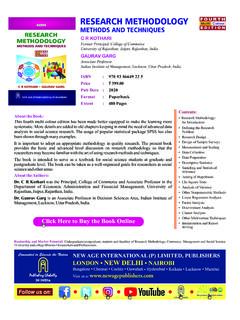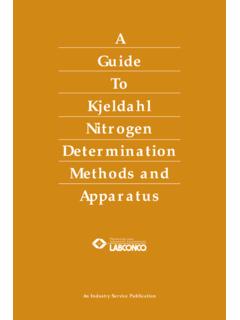Transcription of Energy Sector Market Analysis - NREL
1 A national laboratory of the Department of EnergyOffice of Energy Efficiency & Renewable EnergyNational Renewable Energy Laboratory Innovation for Our Energy Future Energy Sector Market Analysis Sponsored by the Weatherization and Intergovernmental Program (WIP) at DOE D. Arent, R. Benioff, G. Mosey, L. Bird, J. Brown, E. Brown, L. Vimmerstedt, J. Aabakken, and K. Parks National Renewable Energy Laboratory M. Lapsa, S. Davis, M. Olszewski, D. Cox, K. McElhaney, and S. Hadley Oak Ridge National Laboratory D. Hostick, A.
2 Nicholls, S. McDonald, and B. Holloman Pacific Northwest National Laboratory Technical Report nrel /TP-620-40541 October 2006 nrel is operated by Midwest Research Institute Battelle Contract No. DE-AC36-99-GO10337 Energy Sector Market Analysis Sponsored by the Weatherization and Intergovernmental Program (WIP) at DOE D. Arent, R. Benioff, G. Mosey, L. Bird, J. Brown, E. Brown, L. Vimmerstedt, J. Aabakken, and K. Parks National Renewable Energy Laboratory M. Lapsa, S. Davis, M. Olszewski, D. Cox, K. McElhaney, and S.
3 Hadley Oak Ridge National Laboratory D. Hostick, A. Nicholls, S. McDonald, and B. Holloman Pacific Northwest National Laboratory Prepared under Task No. Technical Report nrel /TP-620-40541 October 2006 National Renewable Energy Laboratory1617 Cole Boulevard, Golden, Colorado 80401-3393 303-275-3000 Operated for the Department of Energy Office of Energy Efficiency and Renewable Energy by Midwest Research Institute Battelle Contract No. DE-AC36-99-GO10337 NOTICE This report was prepared as an account of work sponsored by an agency of the United States government.
4 Neither the United States government nor any agency thereof, nor any of their employees, makes any warranty, express or implied, or assumes any legal liability or responsibility for the accuracy, completeness, or usefulness of any information, apparatus, product, or process disclosed, or represents that its use would not infringe privately owned rights. Reference herein to any specific commercial product, process, or service by trade name, trademark, manufacturer, or otherwise does not necessarily constitute or imply its endorsement, recommendation, or favoring by the United States government or any agency thereof.
5 The views and opinions of authors expressed herein do not necessarily state or reflect those of the United States government or any agency thereof. Available electronically at for a processing fee to Department of Energy and its contractors, in paper, from: Department of Energy Office of Scientific and Technical Information Box 62 Oak Ridge, TN 37831-0062 phone: fax: email: for sale to the public, in paper, from: Department of Commerce National Technical Information Service 5285 Port Royal Road Springfield, VA 22161 phone: fax: email: online ordering.
6 On paper containing at least 50% wastepaper, including 20% postconsumer waste TABLE OF CONTENTS Executive Summary ..1 Cross- Sector Analytical Approach ..2 Buildings Sector Analysis ..3 Approach and Methodology ..3 Sector Buildings Sector Appendix ..10 Clean- Energy Sector Analysis ..17 Approach and Methodology ..17 Sector Industrial Sector Analysis ..29 Approach and Methodology ..29 Sector Transportation Sector Analysis .
7 36 Approach and Methodology ..36 Sector iii 1 EXECUTIVE SUMMARY This paper presents the results of Energy Market Analysis sponsored by the Department of Energy s (DOE) Weatherization and Intergovernmental Program (WIP) within the Office of Energy Efficiency and Renewable Energy (EERE). The Analysis was conducted by a team of DOE laboratory experts from the National Renewable Energy Laboratory ( nrel ), Oak Ridge National Laboratory (ORNL), and Pacific Northwest National Laboratory (PNNL), with additional input from Lawrence Berkeley National Laboratory (LBNL).
8 The Analysis was structured to identify those markets and niches where government can create the biggest impact by informing management decisions in the private and public sectors. The Analysis identifies those markets and niches where opportunities exist for increasing Energy efficiency and renewable Energy use. DOE s Weatherization and Intergovernmental Program provides tools, information, and technical and financial assistance to help inform decisions by states, communities, tribal authorities, businesses, manufacturers, consumers, and international partners on the use of Energy efficiency and renewable Energy technologies and policies.
9 This Analysis took a fresh look at key decisions that are driving the use of renewable Energy and Energy efficiency in buildings, electricity, industrial, and transportation markets. For these markets, the Analysis identified opportunities to increase the use of renewable Energy and Energy efficiency technologies and practices. The Analysis attempted to answer the following questions: What are the current markets that WIP programs are addressing and what impacts is WIP having on these markets? What are the markets and segments within each Market that hold the most potential for increased RE and EE deployment?
10 What are the major barriers for each of the markets and segments? Who are the key customers and decision makers in each Market and Market segment, and what needs do they have for information or assistance. Who are the other key actors in each Market and Market segment, what activities are they pursuing, and what opportunities exist for government to leverage resources and capabilities with these players? A common structure and format for the sectoral analyses was developed and performed for each of the target sectors: buildings, clean Energy , industry, and transportation.
















